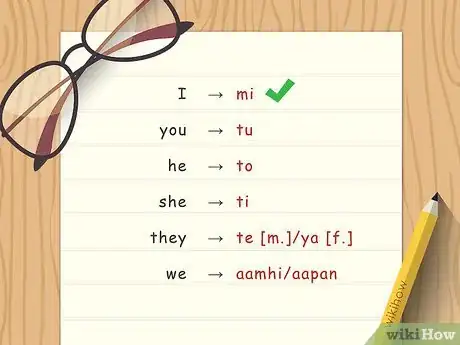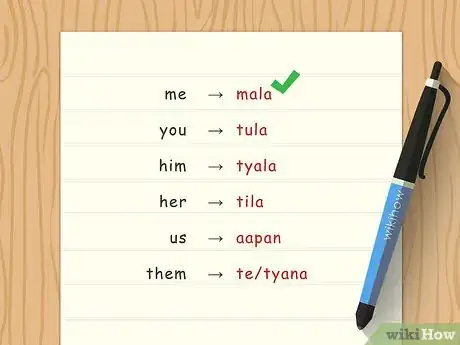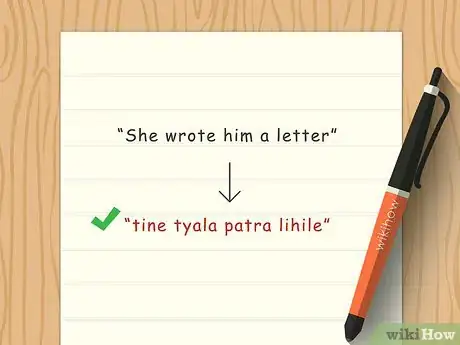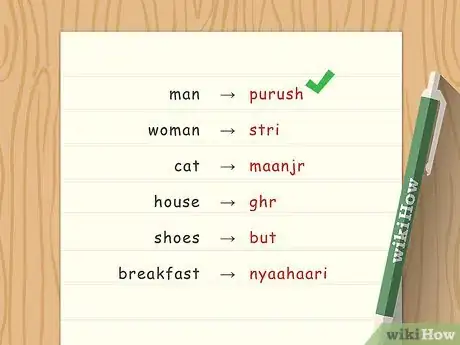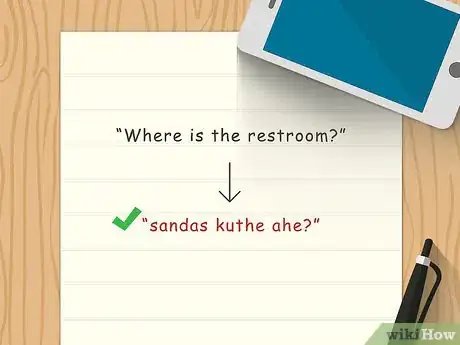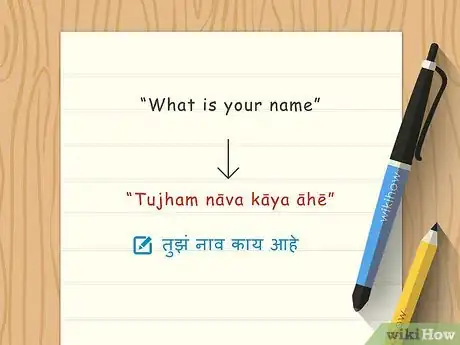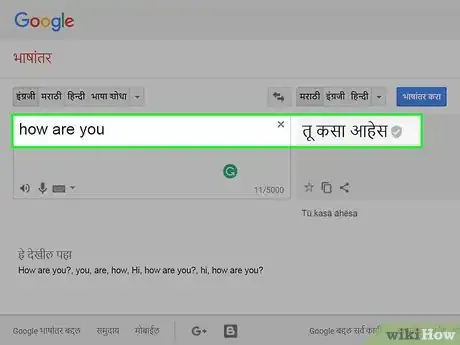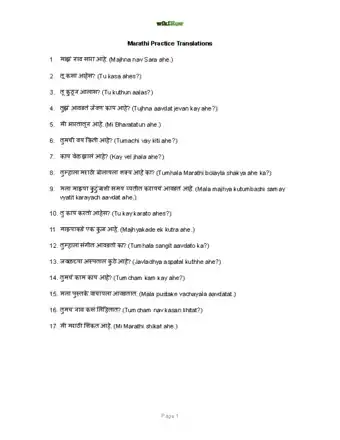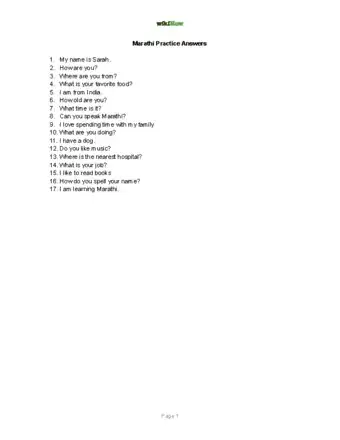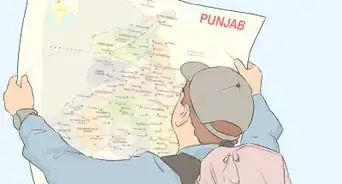This article was co-authored by Tian Zhou. Tian Zhou is a Language Specialist and the Founder of Sishu Mandarin, a Chinese Language School in the New York metropolitan area. Tian holds a Bachelor's Degree in Teaching Chinese as a Foreign Language (CFL) from Sun Yat-sen University and a Master of Arts in Teaching English to Speakers of Other Languages (TESOL) from New York University. Tian also holds a certification in Foreign Language (&ESL) - Mandarin (7-12) from New York State and certifications in Test for English Majors and Putonghua Proficiency Test from The Ministry of Education of the People's Republic of China. He is the host of MandarinPod, an advanced Chinese language learning podcast.
There are 13 references cited in this article, which can be found at the bottom of the page.
This article has been viewed 279,887 times.
Marathi is an Indo-European language spoken by the people of Maharashtra, India, and is one of the official languages of Western India. Because Marathi is not as widely spoken as languages like Hindi and Bengali, it can be difficult to find places offering formal courses outside of India. However, that doesn’t mean you’re out of options. If you’re interested in learning Marathi, a good way to start is by familiarizing yourself with simple words, phrases, and grammatical structures. You can then strengthen your understanding of the language by reading Marathi texts, watching movies and TV shows in Marathi, and engaging in casual conversation with a native speaker.
Steps
Getting Acquainted with the Basic Rules
-
1Memorize the primary personal pronouns. Personal pronouns are extremely important in Marathi—in fact, they make up about 20% of ordinary daily exchanges. As such, they make a good starting point for learning the language. The most common pronouns in Marathi are:[1]
- mi (I)
- tu (you)
- to (he)
- ti (she)
- te [m.]/ya [f.] (they)
- aamhi/aapan (we)
- It’s important to note that the language makes a distinction between the male and female forms of a pronoun.
- There is also a third, neutral gender case for most nouns called the neuter that typically ends in "e". In the neuter, a noun like the masculine "ghoda" (horse) becomes "ghode," with no specified sex.[2]
-
2Learn the indirect object form of each pronoun. The indirect object of a sentence receives the direct object or its effects. In the sentence "The cashier handed me the receipt," for instance, the direct object is "me." When used in their indirect object form, the primary pronouns become:
- mala (me)
- tula (you)
- tyala (him)
- tila (her)
- aamhala (us)
- te/tyana (them).
Advertisement -
3Understand proper sentence structure. In Marathi, the subject of a sentence comes first, followed by the object and finally the verb. To say “I speak Marathi,” for example, you would say “mi marathi bolto.” Arranging the sentence this way establishes a direct relationship between two things that are tied together by an action.[3]
- Some other examples of the subject-object-verb structure include “tine tyala patra lihile” (“She wrote him a letter”) and “to ingarji baolato” (“He speaks English”).
-
4Familiarize yourself with common nouns. These words point to objects, places, directions, ideas, and anything else that can be either the subject or object of a sentence. There are countless nouns to learn, and they’ll become more complex as your understanding of the language continues to improve. For now, concentrate on picking up elementary words, such as:[4]
- “man” (purush)
- “woman” (stri)
- “cat” (maanjr)
- “house” (ghr)
- “shoes” (but)
- “breakfast” (nyaahaari)
-
5Get a few key phrases down. When learning any new language, it can help to begin with the kind of practical statements and questions that you might use on a daily basis. “Tu kasa ashes,” for example, means “How are you?” You might also want to be able to say “mazha nav Carol ahe” (“My name is Carol”), or “mi America hon alo” (“I am from America”). Other useful phrases include:[5]
- "namaskar" ("Hello")
- "yeto" [m.]/"yete" [f.] ("Goodbye")
- "thumhala bhetun anandha jhala" ("Pleased to meet you")
- "abhari ahe" ("Thank you")
- "maf kara" ("Sorry")
- "mala samajatha nahi" ("I don't understand")
- “punha sanga” (“Please say that again”)
- “sandas kuthe ahe?” (“Where is the restroom?”)
-
6Study the Marathi alphabet. Marathi uses the Devanagari alphabet to render its consonant and vowel sounds into writing. There are 33 primary consonants and 9 vowel sounds, resulting in 297 possible pairings that can be combined to make longer words. The complete alphabet is as follows (the letters in brackets show the IAST transliteration into English):[6]
- अ ("a")
- आ ("ā")
- इ ("i")
- ई "ī")
- उ ("u")
- ऊ ("ū")
- ऋ ("ṛ")
- ॠ ("ṝ")
- ऌ ("ḷ")
- ॡ ("ḹ")
- ए ("e")
- ऐ ("ai")
- ओ ("o")
- औ ("au")
- अं ("aṃ")
- अः ("aḥ")
- ॲ / ऍ ("ê")
- ऑ ("ô")
- क ("ka")
- ख ("kha")
- ग ("ga")
- घ ("gha")
- ङ ("ṅa")
- ह ("ha")
- च ("ca")
- छ ("cha")
- ज ("ja")
- झ ("jha")
- ञ ("ña")
- य ("ya")
- श ("śa")
- ट ("ṭa")
- ठ ("ṭha")
- ड ("ḍa")
- ढ ("ḍha")
- ण ("ṇa")
- र ("ra")
- ष ("ṣa")
- त ("ta")
- थ ("tha")
- द ("da")
- ध ("dha")
- न ("na")
- ल ("la")
- स ("sa")
- प ("pa")
- फ ("pha")
- ब ("ba")
- भ ("bha")
- म ("ma")
- व ("va")
- The Devanagari alphabet is written left to right in horizontal lines, much like many European languages. This should make it a little more intuitive for people who are used to Western ways of reading and writing.
- Each distinct vowel sound denotes the way a word should be spoken. For instance, “aṃ” indicates a nasal inflection, while “ah” calls for a slight breathy sound at the end of the syllable.[7]
Learning from Traditional Resources
-
1Sign up for a Marathi class in your area. If you live somewhere with a large Indian population, you may be able to find someone that teaches Marathi. The list of foreign language courses offered at your local university or community college is a good place to start. Formal instruction is arguably the best way to learn, as it allows you to stick to an organized curriculum and interact directly with other speakers.
- Use the power of the internet to discover Marathi classes nearby by searching for “Marathi language” and the name of your city.
- Keep an eye out for newspaper ads, flyers, and social media groups advertising personal tutoring, as well.
-
2Find an online tutor. Sites like italki and VerbalPlanet help connect students with private instructors over the internet. Classes are typically carried out via Skype, which gives you an opportunity to apply what you know in direct exchanges with your tutor. A live chat format can also be beneficial, as it introduces essential reading and writing elements.[8]
- You can find classes set up for a single learner or a group, depending on the website or service you're using.
- Massive Open Online Courses (or MOOCs) are another possible option. The open access and unlimited class size afforded by these web-based platforms makes it possible for anyone interested to sit in on a lesson at their own convenience.
-
3Buy a Marathi language textbook. Teaching yourself from a book is your next best option if you’re unable to find a class to attend. The foreign language section of most bookstores is full of textbooks on dialects from around the world, and there's a chance that Marathi may be among them. With a textbook, you can study at your own pace and acquire the fundamentals of the language in digestible units.[9]
- One benefit of language textbooks is that the content is typically laid out in a logical order, which makes them easy to follow without the aid of an instructor.
- Make an effort to study at least 1 or 2 chapters or lessons per week, or whenever your schedule allows.
-
4Look up words and phrases on the internet. The internet has helped make many extensive language databases available for little or no cost, including free resources such as FluentU and Livemocha. Compare several sites until you find one that offers Marathi. The lesson plans on these sites are put together by fluent speakers and tailored to make them accessible for learners of all levels.[10]
- Sites like these are especially handy when you need to refer to the meaning of a particular word or find out how to say something quickly.
- Check out forums, websites, and social media accounts dedicated to learning Marathi.
Polishing Your Comprehension Skills
-
1Watch movies and TV shows in Marathi. The Marathi people have their own thriving film industry, and these productions can serve as useful educational tools in their own right. To make sure you’re able to absorb what you’re seeing, start with programs aimed at young viewers and work your way up from there. Play close attention to the dialogue and see how many words and phrases you can pick out from memory.[11]
- If possible, turn on the subtitles in your native language. Seeing the dialogue written out will help you create associations between what you hear and the meaning displayed on screen.
- Movies often depict normal people in normal situations, which means you’ll be getting a valuable glimpse of how the language is used in everyday life.
-
2Listen to Marathi music. Throw on a pair of headphones and jam out to some Bela Shende or Raja Hasan during your workout or on your walk home from school. Because of its uncomplicated lyrical structure and repetitive nature, popular music can help reinforce language skills without ever feeling like work. Another plus to using music as a study aid is that you can pause and rewind a song whenever you come to a section you don’t understand.
- Maharashtra has produced many famous playback singers for Indian movies, so much of the music that comes out of the region contains vocals sung in Marathi.
- You can find recordings from many famous Marathi artists on websites like YouTube.
-
3Read short writings in Marathi. Pick up a newspaper or magazine printed in Marathi and try to decipher as much as you can. This is great practice for going over the many symbols of the Marathi alphabet. As your comprehension improves, you can move onto more difficult material like novels and technical essays.
- Focus on headlines, blurbs, and other short passages on your first few attempts to keep from being overwhelmed.
- Children’s books and nursery rhymes are perfect for brushing up on basic Marathi grammar.[12]
-
4Talk with a friend who speaks Marathi. Ask someone who’s fluent in the language if they would be willing to help you practice by carrying on a short conversation. They’ll be able to adapt to your individual skill level, help you with your pronunciation, and gently correct your mistakes. When learning to speak an unfamiliar language, there’s no substitute for firsthand experience.[13]
- Many Indian people speak more than one dialect. It’s possible that your friend might have a good grasp of conversational Marathi, even if they’re not from Maharashtra.
- If you don’t personally know anyone who speaks Marathi, try making a new friend online who you can chat with via Skype or FaceTime.
Practice Translations and Answers
References
- ↑ http://ilovelanguages.org/marathi_lesson8.php
- ↑ http://www.languagesgulper.com/eng/Marathi.html
- ↑ http://learn101.org/marathi_grammar.php
- ↑ http://ilanguages.org/marathi_vocabulary.php
- ↑ https://www.omniglot.com/language/phrases/marathi.php
- ↑ https://www.omniglot.com/writing/devanagari.htm
- ↑ http://www.ancientscripts.com/devanagari.html
- ↑ https://www.fluentin3months.com/online-language-teacher/
- ↑ https://www.fluentu.com/blog/foreign-language-textbooks/
- ↑ http://www.telegraph.co.uk/education/educationadvice/10218763/Learn-a-language-for-free-the-five-best-websites.html
- ↑ https://timesofindia.indiatimes.com/entertainment/marathi/movies/top-20-best-marathi-movies-of-2017
- ↑ http://www.indif.com/kids/marathi_rhymes/nursery_rhymes.aspx
- ↑ https://www.quora.com/How-can-I-learn-Marathi-language
About This Article
To learn Marathi, start by listening to music, and watching movies and TV shows in Marathi to begin immersing yourself in the language. Next, use free online language databases like FluentU and Livemocha to start learning key phrases. Then, consider going to italki.com to find an online tutor or signing up for a class at a college. If you’re unable to find a class to attend, purchase a Marathi language textbook online or at a bookstore that you can study at your own pace. To learn more, like how to form proper sentences in Marathi, read on!
